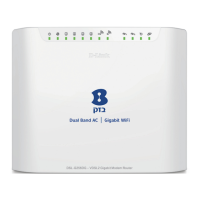
Do you have a question about the D-Link DSL-G256DG and is the answer not in the manual?
| LAN Ports | 4 x 10/100/1000Mbps |
|---|---|
| QoS | Yes |
| VPN Passthrough | Yes |
| Device Type | Wireless router |
| WAN Ports | 1 x RJ-11 |
| Wireless Standard | 802.11b/g/n |
| Wireless Speed | Up to 1200 Mbps |
| Frequency Band | 2.4 GHz / 5 GHz |
| Security | WPA/WPA2 |
| Firewall | NAT |
| VPN Support | PPTP, L2TP, IPSec |
| Power Supply | 12V DC |
Lists items included in the product packaging.
Outlines the necessary hardware and software for setup and use.
Details the key functionalities and capabilities of the router.
Describes the indicators and ports located on the front of the router.
Details the ports and buttons located on the rear of the router.
Lists prerequisites and preparation steps before starting router installation.
Provides important considerations and requirements for a successful router installation.
Guides users through the physical setup steps of the router.
Instructions on how to power up the router.
Explains how to perform a factory reset on the router.
Details how to connect network cables to the router.
Covers the initial steps to access the router's web interface.
Configuring WAN settings for internet connectivity.
Configuration options for the 2.4GHz wireless band.
Configuration options for the 5GHz wireless band.
Settings for the Local Area Network (LAN) configuration.
Configuration for IPv6 automatic network setup.
Setting the router's current time and date.
Advanced configuration settings for 2.4GHz wireless.
Advanced configuration settings for 5GHz wireless.
Configuring rules to forward incoming traffic to specific devices.
Setting up rules to open ports dynamically when specific traffic is detected.
Configuring the Demilitarized Zone (DMZ) host settings.
Setting up and managing parental control features.
Configuring inbound and outbound traffic filtering rules.
Configuring Domain Name System (DNS) server settings.
Setting up and managing dynamic DNS hostnames.
Utilizing diagnostic and management tools for the network.
Configuring static routes and default gateways for network traffic.
Configuring IPSec VPN tunnel connections.
Managing and viewing device power settings.
Configuring Digital Living Network Alliance (DLNA) media server.
Viewing and managing information related to storage services.
Configuring IP tunneling services like IPv6-in-IPv4.
Managing local and trusted CA security certificates.
Configuring and enabling the on-board print server.
Configuring Samba connectivity for file and printer sharing.
Performing system maintenance like backup, update, and reboot.
Updating the router's firmware to the latest version.
Configuring login username and password for the web interface.
Running tests to diagnose connection and device status.
Viewing and configuring system event logs.
Viewing system and internet connectivity information.
Listing all currently connected DHCP clients.
Viewing statistical information about network interfaces.
Displaying information about the router's routing table.
Displaying information about configured WAN interfaces.
Displaying Address Resolution Protocol (ARP) information.
Navigating the help system structure.
Accessing help information for the Setup category.
Accessing help information for the Advanced category.
Accessing help information for the Maintenance category.
Accessing help information for the Status category.
Explains fundamental networking concepts and IP address verification.
Provides an introduction to wireless networking concepts and types.
Details different levels of wireless security options like WPA/WPA2.